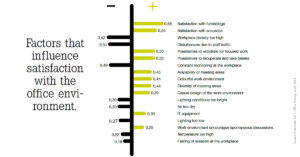Please do not disturb! Privacy in the open office.
By Astrid Hütter, 29.01.2018

Together one is less alone! This statement hits nail on the head with respect to the current situation in open offices, as one is always in good company in an open space! This is an ideal condition for teamwork. However, what does the situation look like for tasks which require a high level of concentration? And how can individual private sphere be integrated into open space?
The major trends in the past few years in modern office architecture were flexible spatial concepts which support employee collaboration. The aim was to break through impasses and barriers to communication, and office design was transformed from closed rooms to open spaces. Open offices continue to be considered the ideal location for working effectively in a team. However, with all these benefits a fundamental need increasingly falls by the wayside: Our privacy! In their “Office Settings” study (2014), the Fraunhofer Institute defines the role of the work environment in a hyper-flexible working world. In addition to satisfaction with the furnishings, also possibilities to withdraw for focused work also have an immense impact on employee satisfaction within the office environment. This fact is particularly interesting from a company’s point of view, as satisfied employees are more efficient and work with greater motivation. Privacy basically is the possibility to selfregulate proximity and distance or special, personal information and environmental influences. In the age of the digitalised working world, another understanding of privacy has meanwhile established itself: Private sphere is no longer only to be viewed territorially but also, with regard to passing on private information, in a social and technological manner. The need for private areas is also quite dependent on the country and company culture, the employee’s personality and current mood, as well as the task itself. The need for areas to withdraw to also fluctuates during the course of a day, depending on whether routine duties or tasks that requires high levels of concentration are pending. It is precisely this fact that should be the focus of office space planning.
Back to the cubicle?
Modern knowledge work in particular demands massive capacities for concentration: The volume of information is increasing rapidly and the processing tempo accelerates. However, to promote innovation and remain competitive, swift and spontaneous communication, cooperation and teamwork also play a major role. Social contacts, just like privacy, are a basic human need and a prerequisite for a company’s productive further development. Hence, the path by no means leads back to cubicle offices. The key to success lies much more in a balanced spatial concept – every workplace should offer a counterbalanced ratio between seclusion and Access.
Tailor-made private sphere.
Bernhard Kern, Managing Director of Roomware Consulting GmbH, describes the golden rule for integrating privacy into the strategic workplace planning as follows: “The gist is to provide employees with different environments which offer a supportive ambience depending on the task, with different open, screened and closed rooms – these diversified work environments provide a balanced spatial concept, thus guaranteeing that employees can choose the environment which best corresponds to their current needs or duties.” This supports the well-being and motivation of the employees and hones the company’s corporate identity while strengthening employee loyalty towards the company as a strategic instrument in employer branding. People seeking inspiration will encounter creative ideas in a lively working café, people who would like to pursue focused work will find what they are looking for in quiet rooms. Confidential matters are discussed in conference rooms or separate offices which are available to all employees as needed. Routine tasks can be handled in open spaces without difficulty – thus people are also open for informal communication, which is so important for knowledge transfer in companies.
Clear set of rules and a clear culture.
In addition to a well-considered zoning of office spaces, clear rules and a clear culture are key: Companies can define rules which ensure acceptable conduct regarding the private sphere of employees. Two examples:
- Telephone calls at the desk are kept brief. For longer discussions please use the zones provided for this.
- The mobile phone ringtone in the office is set to quiet or silent. A vibrating alarm alerts to incoming calls.
Naturally, these rules should also be practiced by supervisors – this increases acceptance by employees.





